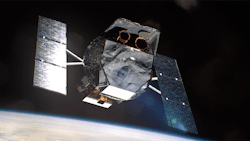NASA studies potential orbit boost for Swift Observatory to extend mission life
Questions and answers:
What broader impact could this have? Success could demonstrate on-orbit servicing capabilities that extend the lifespan of other government and commercial satellites.
What is NASA studying for the Swift Observatory? NASA is funding studies to explore raising the orbit of the Neil Gehrels Swift Observatory to counteract atmospheric drag and extend its mission.
Which companies are involved? Cambrian Works in Reston, Va., and Katalyst Space Technologies in Flagstaff, Ariz., are developing concept studies for the mission.
WASHINGTON - The National Aeronautics and Space Administration (NASA) is funding industry studies on a potential mission to raise the orbit of its Neil Gehrels Swift Observatory, a nearly 21-year-old spacecraft facing accelerated orbital decay due to heightened solar activity.
The agency has awarded $150,000 Phase III Small Business Innovation Research contracts to Cambrian Works in Reston, Va., and Katalyst Space Technologies in Flagstaff, Ariz.. Both companies will develop concept studies for an in-space demonstration that could boost Swift’s altitude, helping extend its science mission and advancing on-orbit servicing capabilities for U.S. satellites.
Swift, launched in 2004, is a key tool for detecting gamma-ray bursts and relaying rapid follow-up data to ground-based and space observatories worldwide. It operates in low-Earth orbit, which has been affected by increased atmospheric drag caused by higher solar activity in the current solar cycle. Without intervention, Swift’s orbit could continue to decay at a rate that shortens its expected mission life.
Evaluation goals
The concept studies will evaluate the technical, operational, and economic feasibility of a boost maneuver, including propulsion options, rendezvous and docking techniques, and potential integration with other on-orbit servicing missions. NASA is also working with Starfish Space in Seattle to assess the use of its Small Spacecraft Propulsion and Inspection Capability technology demonstration as a candidate for executing the orbit-raising operation.
While no boost mission has been approved, NASA officials say the findings will inform decisions on whether orbit servicing is more cost-effective than replacing the spacecraft. The effort also aligns with broader goals to develop technologies for extending the operational life of satellites, which could have significant applications for commercial, civil, and national security space systems.
NASA expects the studies to provide key insights into performance requirements, servicing safety protocols, and risk management strategies for operating with aging spacecraft. Officials say preserving Swift’s capabilities would not only continue valuable gamma-ray research but also demonstrate the viability of extending satellite lifespans through targeted orbital servicing missions.
